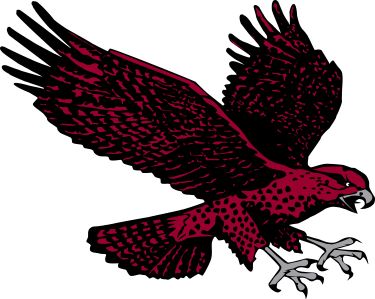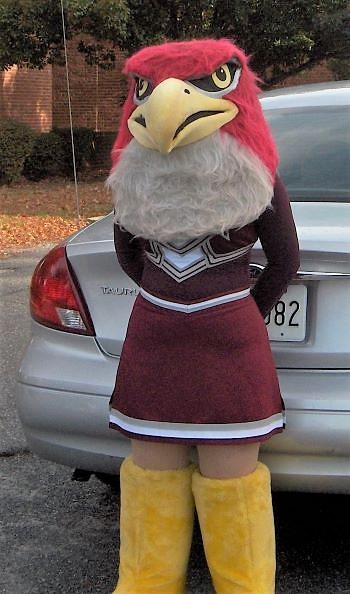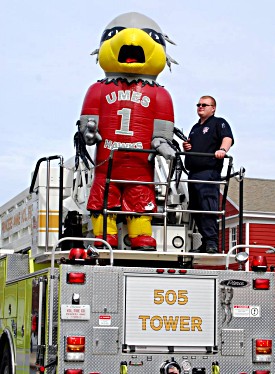“The Hawk”
‘They want to call us what?’ …

John Mitchell, a running back from Ohio on Maryland State College’s 1948 football team, and teammate Leonard Cisco, a defensive end from New Jersey, were relaxing in the campus canteen one fall afternoon when Charles C. Jacobs, the college’s public relations director, “walked up … in a high state of anxiety saying the newspapers wanted to call (the team) the Fishermen.”
The two student-athletes and Jacobs immediately began throwing out names, none of which they could agree upon. Here is how Mitchell recalls that encounter:
“I remember the football scoreboard had two emblems on it, one to represent the opposing team and one to represent the home team. On the left was a drawing of a Roman soldier’s helmet (galea) and on the right side was a bird, of some sort.”
“What kind of bird was that on the scoreboard?,” Mitchell remembered one of them asking.
Cisco said it was a hawk.
“Professor Jacobs, who also served as the college s public relations officer, and I stared at the ceiling. There were some moans, ‘ahhs and ‘umms.”
“Professor Jacobs walked out of the place. The following week, the papers reported the Maryland State Hawks had beaten (the) mighty Grambling (Tigers)!”
The majestic bird-of-prey nickname stuck. It was a wise choice.
The sports pages of newspapers marketed to Blacks in the post-World War II era curiously used “Fishermen” and “Raiders” to report on Maryland State athletic teams before football became a powerhouse as the “Hawks.”
“The original version of the Hawk was facing right to left, but somewhere in time, it was changed to face the opposite direction,” Mitchell said.
Beginning in the 1960s, “The Hawk” yearbook staff apparently felt free to experiment with displaying the flying direction of the mascot on the cover; some years it was facing right-to-left, just as Mitchell remembers, while other years it faced in the opposite direction — the standard logo in 2011.
Red-tailed and red-shouldered hawks occasionally can be seen soaring above the campus. Few of UMES’ peer institutions can make that claim about their mammal mascots.
— as told by JOHN MITCHELL
How the “Hawk” became “Harry” . . .
Former athletics director Hallie Gregory decided the UMES mascot needed a three-dimensional persona, so one day he ordered a grey and white Hawk suit. The university’s athletic teams had been known as the Hawks since the late 1940s, but it wasn’t until the 1990s that the bird came to life. Thus was born Harry the Hawk.

The original grey and white Hawk was loaned and lived just down Route 13 as the mascot for Holly Grove Christian School, where Dr. Gregory worked in semi-retirement as athletics director. Someday, the original Harry is expected to return to a retirement nest at UMES known as the university archives.
Approximately 10 years ago, UMES purchased a maroon costume that now assumes the role of Harry. In 2007, current Director of Athletics Keith Davidson decided to go “big” and approved the purchase of a nine-foot inflatable walk-about suit.

“Big Harry,” as he is affectionately known, is the pride of the campus. Along with the maroon Hawk, (referring to either one as ‘Harry’ is correct) “Big Harry” delights crowds at public events across the Eastern Shore and Mid-Atlantic region.
Harry is a fixture at most UMES athletic contests and campus functions, and also maintains an Internet presence on popular social networking sites.
As a campus ambassador, he makes appearances for non-profit groups and at Arthur Perdue Stadium in Salisbury to celebrate the birthday of his close feathered friend, Sherman the Shorebird. Harry also maintains a friendly rival relationship with Sammy the Seagull, Salisbury University’s mascot.
“Big Harry’s” coming out party was Oct. 14, 2007 at Hawk Hysteria, the annual pep rally signaling the start of college basketball season. Many others in the local mascot menagerie, including Sammy (the Salisbury University seagull) and Sherman (the Delmarva Shorebird mascot), show up for his birthday celebration.
Promoting UMES and Hawk Pride is “Job 1” for Harry wherever he goes.

